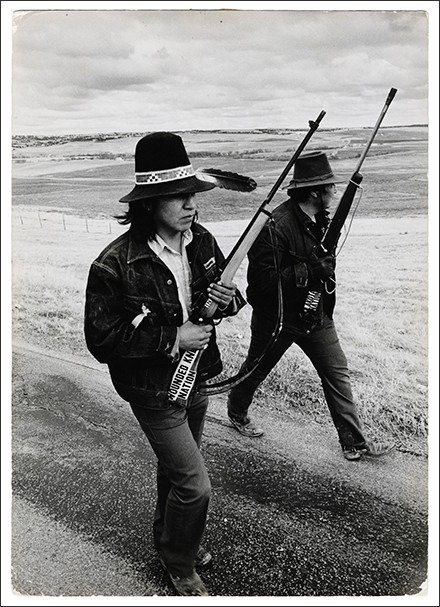Two exhibitions
dal 17/9/2013 al 14/12/2013
Segnalato da
Vernon Ah Kee
Sonny Assu
Scott Benesiinaabandan
Dana Claxton
Cheryl L'Hirondelle
Alan Michelson
Theo Sims
Skawennati
Jackson 2bears
Gerda Cammaer
Pierre Tremblay
Steve Loft
17/9/2013
Two exhibitions
Ryerson Image Centre RIC, Toronto
"Ghost Dance: Activism. Resistance. Art." This exhibition is not meant to be a comprehensive history of activism in Indigenous art. It is part of an ongoing journey. "Moving Frames, Shifting Boundaries": Artistic Experiments and Innovation in Film and Video.

Guest Curated by Steve Loft
On January 1, 1889, Jack Wilson (or Wovoka), a young Paiute man, had a vision during an eclipse of the sun. […] Revealed to Wilson was a place where his ancestors were once again engaged in their favourite pastimes, where wild game and abundant food were restored to the lands. […] He interpreted the vision as the coming of a new age, one where Native and non-Native people would (finally) live in peace. This was the birth of the Ghost Dance. [...] It was, quite possibly, the first pan-Indian movement in the United States.[1]
This exhibition is not meant to be a comprehensive history of activism in Indigenous art. It is part of an ongoing journey.
Colonialism has been the cause of the suffering, oppression and violence perpetuated against Indigenous people in Canada and many other countries, for centuries. But attributing the rise of resistance, activism and the art associated with it to colonialism itself, is disingenuous. It is the interactions of people which manifest the destructive ideologies inherent in colonialism. The events caused by these interactions change people and their societies. Indigenous art is not predicated on “colonialism”, but on the events caused by it.
As a curator and art historian I would posit that Aboriginal art is innately political. It is the culmination of lived experiences, from pre-contact customary societies through the colonial enterprise. It is tied up in histories that include both pre- and post-contact epistemologies, narratives empowered by continuity, inextricably inter-linked; and it is the assertion of cultural autonomy and sovereignty.
The artists in this exhibition - most, but not all, Aboriginal - have, and continue to engage in a particular activism, which I would characterize as “articulate resistance”, a social engagement specific to the history of colonization and continued racism.
The work of Indigenous artists needs to be understood through the clarifying lens of sovereignty and self-determination, not just in terms of assimilation, colonization and identity politics […] Sovereignty is the border that shifts Indigenous experience from victimized stance to a strategic one.[2]
Ghost Dance examines the role of the artist as activist, as chronicler and as provocateur in the ongoing struggle for Indigenous rights and self-empowerment.
Force, no matter how concealed, begets resistance. (Lakota saying)
Steve Loft
Guest Curator
National Visiting Trudeau Fellow
[1] Candice Hopkins, "Can Beauty Be A Call to Action", in Close Encounters: The Next 500 Years, ed. Sherry Farrell Racette (Plug In Editions: Winnipeg, 2011), 65.
[2] Jolene Rickard, “Sovereignty: A Line in the Sand,” Aperture 139 (Spring 1995): 51.
Artists: Vernon Ah Kee, Sonny Assu, Scott Benesiinaabandan, Dana Claxton, Cheryl L’Hirondelle, Alan Michelson, Theo Sims, Skawennati and Jackson 2bears.
This exhibition is made possible through the generous support of the Trudeau Foundation, the Ontario Cultural Attractions Fund, the Ontario Arts Council, the Canada Council for the Arts, the Toronto Arts Council, and the Paul J. Ruhnke Memorial Fund.
--------
September 18 - October 27, 2013
Moving Frames, Shifting Boundaries
Artistic Experiments and Innovation in Film and Video
Guest Curated by Gerda Cammaer and Pierre Tremblay
An ode is an elaborate poem praising someone or something, describing its nature intellectually as well as emotionally. An ode can be serious and meditative, or rather enthusiastic, even ecstatic, but also ironic or humorous. Here the form of the ode comes to life with a wide selection of experimental films and video works produced by the students of the School of Image Arts, Ryerson University, under the mentorship of professors and guest curators Gerda Cammaer and Pierre Tremblay. Showcasing innovative and imaginative single-channel works produced between 2011 and 2013, Moving Frames, Shifting Boundaries presents the talent of our future media artists, functioning as a “salon des promesses”. As all classic odes, the program is structured in three parts, each representing different imaginary worlds, techniques and moods:
I Ode to Experiment (46 mins.)
II Ode to Pop Culture (33 mins.)
III Ode to Iceland (28 mins.)
Image: Michael L. Abramson, American Indian Movement: Lakota Indians, Wounded Knee, South Dakota, 1973. BS.2005.285357 / 187-546. Reproduction from the Black Star Collection at Ryerson University.
Press contact:
Antoine Bourges T +416 979 5000 x7032 abourges@ryerson.ca
The Ryerson Image Centre (RIC) celebrates its first anniversary September 18 from 6 to 8pm with an opening reception
The Ryerson Image Centre (RIC)
33 Gould Street Toronto, Ontario Canada
Hours:
Tue, thu, fri: 11 - 6PM
Wed: 11 - 8PM
sat and sun: 12 - 5PM
MONDAY CLOSED
Admission is free



